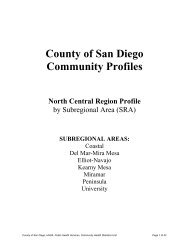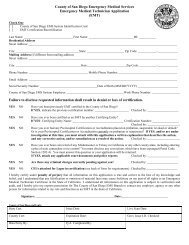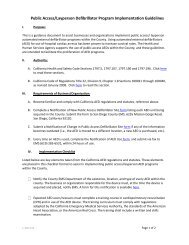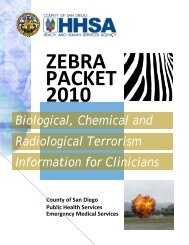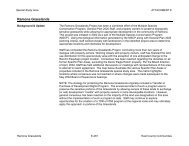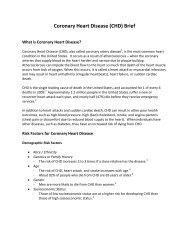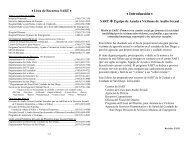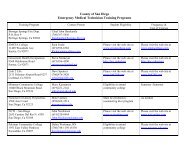CALIFORNIA CODE OF REGULATIONS - State of California
CALIFORNIA CODE OF REGULATIONS - State of California
CALIFORNIA CODE OF REGULATIONS - State of California
You also want an ePaper? Increase the reach of your titles
YUMPU automatically turns print PDFs into web optimized ePapers that Google loves.
Page 645<br />
TITLE 22. DIVISION 5 — LICENSING & CERTIFICATION <strong>OF</strong> HEALTH FACILITIES § 72465<br />
(1) Restraints may be used:<br />
(A) For the protection <strong>of</strong> the patient during treatment and<br />
diagnostic procedures, including but not limited to, intravenous<br />
therapy, tube feeding and catheterization.<br />
(B) To prevent infirm patients from falling out <strong>of</strong> bed or chairs or<br />
otherwise injuring themselves.<br />
NOTE: Authority cited: Sections 208 (a) and 1275, Health and Safety<br />
Code. Reference: Section 1276, Health and Safety Code.<br />
§ 72459. Special Treatment Program Service<br />
Unit—Acceptable Forms <strong>of</strong> Restraints.<br />
(a) Mechanical or behavior restraints are defined as any apparatus<br />
that interferes with the free movement <strong>of</strong> a patient.<br />
(1) Physical restraint means restraint to control an acutely<br />
disturbed person to prevent the person from causing harm to self or<br />
others. The tying <strong>of</strong> hands or feet, whether or not the person is<br />
restrained in a bed, chair or wheelchair, shall be considered a physical<br />
restraint. A physical restraint shall not be confused with a postural<br />
support as defined in Section 72319(k). Only the following types <strong>of</strong><br />
physical restraint may be used:<br />
(A) S<strong>of</strong>t tie consisting <strong>of</strong> cloth which prevents movements <strong>of</strong> a<br />
patient.<br />
(B) Mittens without thumbs which are securely fastened around the<br />
wrist with a small tie.<br />
(C) Cloth vests consisting <strong>of</strong> sleeveless cloth webbing.<br />
(D) Belts and cuffs, which are well padded, used to control a<br />
seriously disturbed, assaultive patient.<br />
NOTE: Authority cited: Sections 208 (a) and 1275, Health and Safety<br />
Code. Reference: Section 1276, Health and Safety Code.<br />
§ 72461. Special Treatment Program Service Unit—Orders<br />
for Restraint and Seclusion.<br />
(a) Restraint and seclusion shall only be used on the signed order<br />
<strong>of</strong> a physician which shall be renewed every 24 hours. In a<br />
documented case <strong>of</strong> emergency, which threatens to bring immediate<br />
injury to the patient or others, a restraint may be applied, and a<br />
physician shall give an order for application <strong>of</strong> the restraint within one<br />
hour. A physician may give the order by telephone. In such an event,<br />
the physician shall sign the order within 5 days.<br />
(b) A daily log shall be maintained in each facility exercising<br />
behavior restraint and seclusion indicating the name <strong>of</strong> the patient for<br />
whom behavior restraint or seclusion is ordered.<br />
(c) Full documentation <strong>of</strong> the episode leading to the behavior<br />
restraint or seclusion, the type <strong>of</strong> behavior restraint or seclusion used,<br />
the length <strong>of</strong> time that the restraint or seclusion was applied or utilized,<br />
and the name <strong>of</strong> the individual applying such measures shall be<br />
entered in the patient’s health record.<br />
NOTE: Authority cited: Sections 208 (a) and 1275, Health and Safety<br />
Code. Reference: Section 1276, Health and Safety Code.<br />
§ 72463. Special Treatment Program Service<br />
Unit—Restrictions on Applying Restraints and<br />
Utilizing Seclusion.<br />
(a) In applying physical restraints, each <strong>of</strong> the following<br />
requirements shall be met in addition to those set forth in Section<br />
72319:<br />
(1) Careful consideration shall be given to the methods by which<br />
the restraints may be speedily removed in the event <strong>of</strong> fire or other<br />
emergency.<br />
(2) Patients placed in restraint shall be observed by qualified<br />
treatment personnel at least every half hour. This observation shall be<br />
noted and initialed in the patient’s health record following each<br />
observation.<br />
(3) Each individual program plan authorizing restraint shall<br />
specify the behavior to be modified, the method to be used, the<br />
schedule for use<br />
<strong>of</strong> the method, the person responsible for the program and the<br />
effectiveness <strong>of</strong> the modality in attaining stated objectives.<br />
(4) Opportunity for motion and exercise shall be provided for a<br />
period <strong>of</strong> not less than ten minutes during each two hours in which<br />
restraint is applied. The exercise periods shall be documented in the<br />
patient’s record.<br />
(b) In utilizing seclusion each <strong>of</strong> the following requirements shall<br />
be met:<br />
(1) Patients placed in seclusion shall be observed by qualified<br />
treatment personnel at least every half hour. This observation shall be<br />
noted and initialed in the patient’s health record.<br />
(2) Each individual program plan authorizing seclusion shall<br />
specify the behavior to be modified, the method to be used, the<br />
schedule for use <strong>of</strong> the method, the person responsible for the program<br />
and the effectiveness <strong>of</strong> the modality in attaining stated goals.<br />
(3) Opportunity for motion and exercise shall be provided for a<br />
period <strong>of</strong> not less than ten minutes during each two hours in which<br />
seclusion is applied. The exercise periods shall be documented in the<br />
patient’s record.<br />
(c) Medication shall not be used as punishment, as a substitute for<br />
a program or for the convenience <strong>of</strong> staff.<br />
NOTE: Authority cited: Sections 208 (a) and 1275, Health and Safety<br />
Code. Reference: Section 1276, Health and Safety Code.<br />
§ 72465. Special Treatment Program Service Unit—Staff.<br />
(a) A registered nurse, licensed vocational nurse or licensed<br />
psychiatric technician shall be employed at least 40 hours a week on<br />
the day shift and be responsible for nursing supervision <strong>of</strong> the distinct<br />
part. If the facility has a total licensed capacity <strong>of</strong> 59 beds or less the<br />
director <strong>of</strong> nursing services may also be the charge nurse for the<br />
distinct part.<br />
(b) Nursing service charge personnel on all shifts shall have at least<br />
one year <strong>of</strong> experience or training related to the special treatment<br />
program services, or shall participate in in–service provided by the<br />
facility.<br />
(c) If the facility is devoted entirely to the care <strong>of</strong> the mentally<br />
disordered, there shall be at least one registered nurse or licensed<br />
vocational nurse on duty on all three shifts seven days per week.<br />
(d) A licensed psychiatric technician may:<br />
(1) Serve as a charge nurse.<br />
(2) Administer medications only in a special treatment program.<br />
(e) The Department may require the licensee to provide additional<br />
pr<strong>of</strong>essional, administrative or supportive personnel whenever the<br />
Department determines through a written evaluation that additional<br />
personnel is needed to provide for the health and safety <strong>of</strong> patients.<br />
Nursing service personnel shall be on duty in the number and with the<br />
qualifications, training, and supervision necessary to meet the<br />
individual care needs <strong>of</strong> patients admitted for care.<br />
(f) Interdisciplinary Pr<strong>of</strong>essional Staff: The facility shall provide<br />
either through direct employment or by contractual arrangement, an<br />
interdisciplinary pr<strong>of</strong>essional staff to develop and implement special<br />
rehabilitation programs and to provide specific expertise to the<br />
program staff, and/or provide direct patient services.<br />
(1) The interdisciplinary pr<strong>of</strong>essional staff shall be composed <strong>of</strong> at<br />
least two <strong>of</strong> the following disciplines:<br />
(A) Psychologist<br />
(B) Social Worker<br />
(C) Occupational therapist<br />
(D) Recreation therapist<br />
(E) Art therapist<br />
(F) Dance therapist<br />
(G) Music therapist<br />
(H) Any other related discipline approved by the Department<br />
(2) Each member <strong>of</strong> the interdisciplinary pr<strong>of</strong>essional staff shall<br />
have a minimum <strong>of</strong> one year <strong>of</strong> experience or training in a mental<br />
health setting.<br />
(3) In addition to general staffing requirements in Section 72329(f)<br />
a facility which provides a special treatment program shall provide<br />
interdisciplinary staff as required in Section 72329(f) in accordance<br />
with the following schedule:



